Overview of aster species and varieties

The types and varieties of aster - a flower that got its name for the star-shaped petals - are quite diverse. But few people know that the botanical name of many popular forms of this garden plant betrays its belonging to a completely different genus - callistephus... Real asters - perennial white and colored, terry and star-shaped, spherical and with a flat rosette, look noble and restrained, are popular in cutting, border plantings, rabatki.

The species diversity of asters includes ageratus, Tatar and Siberian forms, popular alpine, shrub, and European subtypes. With their help, you can easily turn a flower garden into a real riot of colors that persists all year round. High and low varieties of asters can be used in mixed plantings, they are well compatible and harmoniously complement each other in multi-level compositions.
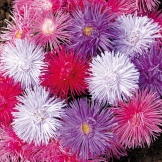


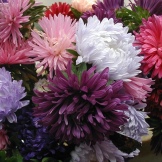
Variety of shades
Asters are characterized by a rich color palette. These plants are also distinguished in the wild by a variety of colors. And in breeding forms, they do amaze with splendor. There are flowers of various shades:
- white;
- yellow
- red;
- blue;
- purple;
- lilac;
- pink
- lilac;
- salmon;
- cream;
- yellow.






The bicolor and tricolor varieties combine these colors in various combinations to form unusually attractive combinations. But carmine-red and snow-white asters, the most common and popular, are considered classics.
Species overview
The classification of asters includes the distinction of plants according to several types of traits. First of all, one-year and perennial varieties are divided. In addition, all asters can be divided into several subtypes.
- Height. Dwarf, up to 25 cm, and undersized, 25-40 cm, varieties are distinguished. And there are also medium-sized asters, up to 65 cm, tall, up to 80 cm. Plants with a stem height of 80-100 cm are considered giant.
- The shape of the bush. There are pyramidal and columnar compact forms, options with an oval crown, wide dense and spreading options. The bush itself can be strongly branched or slightly branched.
- By the size of the flower. Small - almost all border forms, have no more than 4 cm in diameter. The middle ones form baskets up to 4-8 cm. The large ones include flowers with a diameter of 9-11 cm.Giant asters can form inflorescences up to 12 cm.
- By the shape of the inflorescence. Here you can distinguish a structure with tubular petals, reed, mixed, where both forms are present. At the same time, the flower itself can be double, spherical, flat, flat-round, in the form of a hemisphere, simple, semi-double or densely double.
- By scope. Cut and bouquet include tall and giant varieties with large inflorescences. Dwarf and undersized varieties of asters, which form many inflorescences, are called curbaceous. Species of the medium-sized type, with rather large baskets, are considered universal for planting.
- By flowering time. Early buds form 83-106 days after germination, bloom from May to July. Mid-flowering asters delight with the appearance of inflorescences by mid-July. Late ones appear at the end of August, while planting dates should be quite early - at least 120-140 days pass from the release of the first leaves to the formation of buds.




Perennial
This category includes treelike and shrub flowering plants that do not require annual planting. They form a developed root system, are unpretentious, provide regular and long flowering. For the winter, they are cut to the ground, the remaining aerial part 5-10 cm high is covered in order to get abundant flowering the next year.

- European or Italian. Aster amellus is a perennial chamomile aster of European selection, known for over 400 years. The bush is characterized by summer flowering, hemispherical crown shape, stem height in the range of 30-60 cm. European aster varieties bloom from July to September, form large buds with a calyx up to 5 cm in diameter. The color of the petals is varied from pink to lilac, lilac, blue shades, the middle is always yellow.


- Ageratoid.A perennial plant with a developed root system and high stems, up to 100 cm. The upper part of the bush is branched, by the time of flowering in August-September, leaves begin to fall off. The ageratoid aster is characterized by the formation of many small inflorescences with a yellow center and purple petals. In nature, this species is found in Russia - in Primorye, Priamurye, in the Far East.


- Alpine. Aster species Aster alpinus refers to early flowering, dwarf - grows no more than 30 cm in height. At the end of May, baskets in the form of flat daisies 2.5-3 cm in diameter with white, lilac or bright purple petals with a yellow center are formed on the stems. The species is very frost-resistant, hibernates without shelter, every 2-3 years it needs to divide the bush.


- Heather. The plant with the botanical name Aster ericoides is found naturally in North America, and has been used in cultivation since 1732. Aster heather grows tall - from 80 to 105 cm. It is characterized by intense branching, late flowering from September to October, small, no more than 1 cm, the size of the inflorescences. The plant has good frost resistance - this species can be planted in cold climates. Needs an abundance of light.

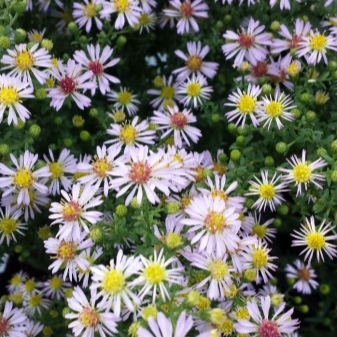
- Bokotsvetnaya. Aster lateriflorus - this is exactly what its botanical name sounds like. Autumn, late flowering species that forms buds in September and keeps them until frost. Flowers are formed at the ends of abundantly leafy shoots, similar to bunches of grapes. The shade of the petals is white or lavender, the center changes its color from yellow to purple. The height of the stems is one of the most significant - up to 120 cm.


- Shrub. The Aster dumosus species is distinguished by erect, dense stems with abundant edging, grows up to 50 cm, frost-hardy. These plants are naturally characteristic of North America. In the breeding form, hybrids with the New Belgian subtype are most often found. As a result, while maintaining the height of the bush, you can get a much greater color variety of buds.


- New Belgian.Virginian or new Belgian selection of asters (Aster novi-belgii) is a perennial, the number of varieties of which reaches 1000 units. In fact, this is not a species, but a hybrid form, combined into a general group with a height range of 30-90 cm. New Belgian asters are sensitive to the type of soil - they turn out to be higher on loams, and on sandy, well-drained soils they are of modest size. Flowering occurs from late October to November, before the first snow.


- New English. Aster novae-angliae is also a hybrid group of cultivars with about 50 varieties. And also New England asters can be found under the name American, since their natural range is located in the latitudes of Quebec, Canada, Kansas and South Carolina in the United States. They have been bred in Europe since 1710, but are much less popular than the New Belgian variety. Plants are frost-resistant, cultivated even in the taiga climatic zone, ideal for informal landscape planting.


- Tatarskaya. Aster tataricus is a shrubby form of a plant that reaches a height of 150-200 cm, but usually grows 30-70 cm.The species blooms in mid-summer from June to September, forming brightly colored baskets with petals of blue, pink or purple. Straight shoots and slight branching make it a good bouquet flower.


- Siberian. The decorative perennial Aster sibiricus is found in nature in the territory from Japan and China to the north of Russia. The plant is medium-sized, up to 40-50 cm, with strong stems, on which basket-like inflorescences are fixed, no more than 4 cm in diameter. Petals are tubular, pinkish-yellow, reed lilac, lilac. The stems are bordered by green, not too dense leaves. This species is characterized by flowering at the end of June, you can achieve an earlier formation of buds by autumn planting.


Annual asters
Unpretentious in care, varied in color and very decorative - annual asters invariably adorn European, American, and Chinese gardens.

- Chrysanthemum. One of the most popular cut types of garden aster, in fact, it is only its distant relative - Chinese callistefus. This plant reaches 65 cm in height, pleases with voluminous hemispherical inflorescences up to 10 cm in diameter and an abundance of colors - from scarlet and burgundy to white, pink, blue. Early flowering, in June the bush is already abundantly covered with buds.

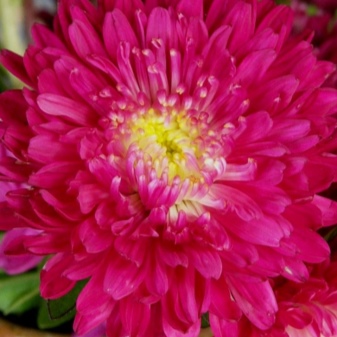
- Peony. One of the most beautiful types of asters. Differs in lush large inflorescences, retains decorative effect until frost. On a medium-sized columnar bush 40-70 cm tall, white, pink, purple, lilac, burgundy, yellow inflorescences up to 15 cm in diameter look spectacular. The flowers are in the shape of a peony, not inferior to him in decorativeness.

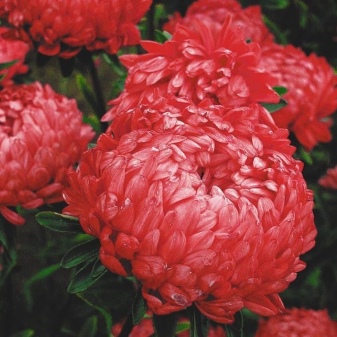
- Needle. A popular annual species with characteristic inflorescences, the petals of which resemble sharp needles. The needle type of asters is cold-resistant, withstands sowing before winter, but needs abundant watering during the growing season. The bushes are pyramidal, erect, with dense stems. They form densely double inflorescences-baskets, reaching 10-15 cm in diameter, 1 plant can have up to 30 buds. This species blooms early, 85-90 days after planting, around July, and lasts until September.


Description of popular varieties
There are many names of aster species, as well as varieties. They are popular due to the variety of colors and shape of inflorescences, general unpretentiousness. The smallest and palm-sized, pompom, terry and other varieties ideally complement the garden space, are used in borders and ridges, decorate balconies and terraces for container breeding. It is worth getting to know the most popular of them in more detail.

Bon-bet
An annual, beautiful variety that grows up to 60 cm tall. The diameter of the opened inflorescences reaches 5 cm. This variety of asters gives white, pink, blue, lilac shades of petals. The "Bon-pari" is characterized by abundant branching of the bush. During flowering, it is all strewn with star-shaped flowers exuding a delicate aroma.


The variety is suitable for growing in open ground, pots, containers. Seedlings of home breeding are planted in the soil upon reaching the age of 30-35 days during the first and second decades of May. Flowering occurs in August, lasts all September.
Tower
The annual, belonging to the peony varieties, is distinguished by long, abundant flowering. The bushes are medium-sized, reach 40-70 cm in height, the stems branch slightly. The variety is found in different color variations, the most decorative are white, yellow, red, silver. These asters are characterized by a spherical inflorescence with elongated outer petals and short ones around the core. The diameter of the blossoming flower reaches 10 cm. Beautiful plants are widely used in cutting when drawing up bouquets. They are able to decorate a balcony or terrace in containers and pots, become a real treasure for any flower bed.

Pavlova
A needle-like aster variety that is very popular for planting.Refers to the clawed species, in which the petals are bent towards the center. The slender, graceful stem reaches a height of 70 cm, up to 10 medium-double buds appear on one plant, resembling a ballet tutu in shape. The color scheme of Pavlova is delicate - even yellow here is very delicate, closer to lemon.

Yabluneva
A very popular peony aster, distinguished by its high resistance to fusarium disease. The variety is distinguished by a lush, spreading bush shape, grows up to 50 cm, on each stem up to 10 corollas. The diameter of the inflorescences reaches 10 cm, in addition, they are distinguished by a spectacular color - with a creamy white base and pale pink, sometimes lilac tips. As the flower unfolds, the brightness of the petals increases.

American Browning
A peony aster variety with magnificent, abundant flowering. In the color of the petals, the whole spectrum of blue-lilac, burgundy, white is presented. The variety is quite tall, up to 70 cm, on a straight stem, double flowers.

Unique
A variety of needle asters with lush inflorescences and a delicate aroma. "Unicum" is distinguished by early and mid-early flowering, the plants reach 70 cm in height, have strong stems, suitable for bouquet cutting. Due to the large diameter of the flower - up to 13 cm - it looks very good in floristic compositions. Especially spectacular are snow-white asters with star-shaped, needle-like petals and a large flower cup.
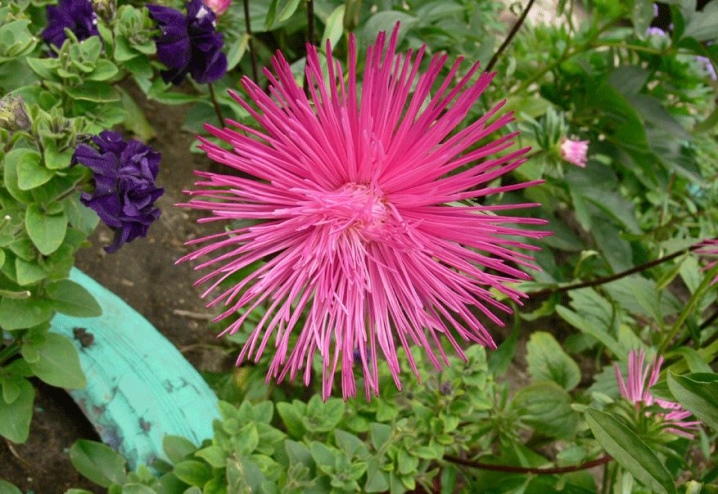
Duchess
Wide-petaled peony variety, characterized by a special inclination of the petals to the center of the rosette. Asters "Duchess" belong to the forms with medium late flowering, their buds are formed in August and September. The stem of the plant is densely branched, rather high, up to 80 cm. Inflorescences are spherical, 9-10 cm in diameter, the palette of colors is very rich, especially decorative red, lilac, pink, purple flowers. The variety is well suited for decorating flower beds, cutting into bouquets.

Royal peony
The largest variety of asters in terms of the diameter of the inflorescences - it reaches 15 cm. The plant has strong, erect stems, a columnar bush, grows up to 80 cm in height. Up to 15 terry corollas grow on each base. The color scheme is presented in 6 shades, the brightest of which is deep blue.

Dwarf and miniature varieties
Separately, it is worth highlighting asters, which differ in their modest dimensions, but no less beautiful from this.

Teise stars
A dwarf variety that grows up to only 15 cm in height. The bush blooms profusely from July to October, it is highly decorative due to the needle-like structure of the inflorescences. "Stars" with a diameter of 6 cm are distinguished by their delicate coloring - the petals are creamy white, pale pink, forget-me-not, purple. The variety is suitable for sowing for the winter, cultivation in pots.

Dwarf royal
Almost the smallest of the existing asters, the bush reaches a height of no more than 20 cm. The variety is border, with snow-white or blue-violet flowers. Terry buds, abundantly pubescent, no more than 8 cm in diameter. Up to 20 flowers can be present on the bush at the same time, which makes the variety especially attractive.

Bon Bon
Pompon aster with lush flowering - the variety forms up to 30-40 inflorescences per season on 1 bush. Differs in compactness and diminutiveness, adult plants reach 20-30 cm in height. The pure white shade of the inflorescences looks very elegant. The hemispherical shape and diameter up to 8 cm allow them to be used for decorating flower beds, potting and container growing. Flowering is medium-early, long-lasting; it is better to plant aster in sheltered, sunny, well-drained areas.

Erfurt dwarf
Peony aster of German selection. It is distinguished by a very compact straight stem no more than 25 cm high. The diameter of the inflorescences reaches 10 cm. The flowers that form on the calyx have a double or semi-double structure and look very decorative. Among the petal color options encountered, one can note white, purple, red, pink and burgundy.

How to choose?
The selection of varieties and types of asters for planting should start with those common in Russia. it Aster alpinus, Áster améllus, Aster sibiricus, Aster tataricus... They are found in Eurasia and are suitable for planting in open ground without additional shelter. When choosing varieties, it is imperative to take into account not only acclimatization. It is worth paying attention to several important nuances.
- Flowering time. In order for the flower garden to please the eye all year round, it is worth using early, middle, mid-late varieties when forming it.
- Flowering duration. It can be short-term or long-term. Late varieties are especially famous for their long flowering.
- Branching of the plant. A very dense weave of shoots violates decorativeness. Plants on separate stems, for which abundant branching are unusual, look especially impressive.
- Height. For planting in curbs, mixborders, the smallest varieties of asters are used. Medium and tall, with stems of 40-100 cm, suitable for flower beds, potting, and cutting and arranging bouquets.
- Terry degree. The most effective pompom and thick double asters, but semi-double varieties look attractive.
- Coloring. For mixed plantings, mixes of flowers of the same variety are used, they always look especially impressive and expressive. Bright crimson, pink, blue, purple, red inflorescences are harmoniously complemented by snow-white neutral notes.

When selecting asters for planting, it is recommended to take into account the atmospheric temperatures, and not to rush to place them in the open ground. In some climatic zones, they need compulsory greenhouse cultivation or container planting with compulsory placement in the warmth during the cold snap.
Watch a video on the topic.






































































































The comment was sent successfully.